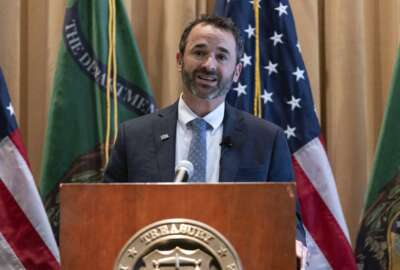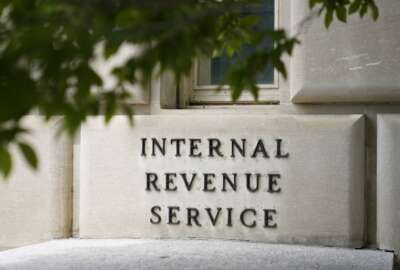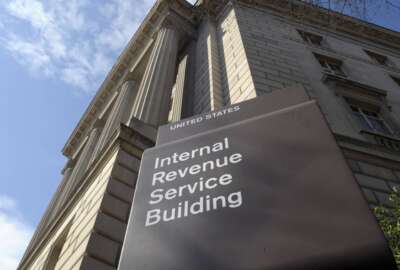
IRS warns bill to end $80B modernization fund will ‘eviscerate’ plans for improved service
The IRS is warning House lawmakers that plans to eliminate nearly $80 billion in agency modernization funds would stall ongoing plans to improve taxpayer services.
The IRS is warning House lawmakers that plans to eliminate nearly $80 billion in agency modernization funds would stall ongoing plans to improve taxpayer services.
The IRS, using about 1% of the nearly $80 billion received in the Inflation Reduction Act, went from answering 15% of calls in 2022 to answering 87% of calls this year.
But the House last week passed a bill that would raise the debt ceiling in exchange for rolling back all unspent funds the IRS received in the IRA to rebuild its workforce and upgrade its legacy IT systems.
The White House says the Limit, Save, Grow Act would result in a 22% cut to nondefense discretionary spending, and would result in the reduction of tens of thousands of federal positions.
IRS Commissioner Danny Werfel told the House Ways and Means Committee last week that zeroing out the agency’s IRA funds would cut short plans to rebuild its workforce and modernize its legacy IT.
“If you repeal the Inflation Reduction Act, you eviscerate our ability to fix the problems that we’ve had historically,” Werfel said last Thursday.
The IRS’s report card for this year’s filing season shows the agency exceeded its own hiring goals. The IRS hired nearly 6,000 customer service representatives and onboarded nearly 3,000 submission processing employees.
The IRS plans to hire about 20,000 employees by the end of fiscal 2024, with most of the hiring focused on taxpayer services and enforcement.
However, many of these hires are meant to cover retirements and employees leaving the agency.
Werfel told the committee that 16,000 IRS employees are expected to retire through fiscal 2024.
“This is not all about plussing up IRS staff. We are also making up for the staff that we are losing to retirement and other attrition,” Werfel said.
The IRS, however, is looking to increase staffing to keep pace with an increasingly complex tax code. Werfel said the IRS currently has the same number of employees as it did in the 1970s.
“That means we get more phone calls to our call centers. That means we get more people walking into our walk-in centers. If we don’t have the staff to meet them, answer their questions, then we are failing the American people and not doing our job to serve them,” he said.
While House lawmakers, during a four-hour hearing, continued to express reservations about the IRS’s hiring plans, Werfel said that the agency is focused on improving taxpayer services and reducing a tax gap between what taxpayers owe and what the IRS collects.
Werfel said the tax gap is around $500 billion a year, but said estimates vary.
“We have to evolve the way we measure the tax cap, because of how quickly that landscape is changing for high-income filers. We can’t measure effectively what we can’t see. And the reality is, is because we’ve been under-resourced and haven’t had the capacity to assess these complicated returns,” he said.
Werfel has repeatedly told lawmakers that the IRS’s annual budget supports its day-to-day operations, while the nearly $80 billion in Inflation Reduction Act supports agency modernization efforts.
“It is the difference, for example, between just having the person to answer the phone when it comes in for the IRS, versus having the option to do a callback, versus having a bot set up so rather than wait, I can get my transcript by just hitting one or two,” he said.
Meanwhile, lawmakers are still scrutinizing how many IRS employees are working in the office.
Werfel said that “not everyone is in the office,” but didn’t have exact figures on how many IRS employees are typically working from home or in the office.
“It is a mix, like all other federal agencies. I would emphasize that everyone’s working. I will say that in my first few weeks at the IRS, the question that I focused on with the IRS right now is are we getting the job done? Are we answering the phones? Are we fighting off cyberattacks? Are we processing the backlog? As long as the answer to that question is yes, then that’s going to be my priority,” he said. “Now if the answer is no, then I want to go deeper into the issue and figure out what the issue is, and if the issue happens to be the telework policy is negatively impacting our ability to get the job done for the American people, then we will make a change.”
Rep. Nicole Malliotakis (R-N.Y.) said her office had to intervene with the IRS on behalf of more than 500 of her constituents unable to get through to the IRS, and urged the IRS to bring more employees back to the office.
“I would love to suggest that it’s time to bring everyone back to the workplace,” Malliotakis said. “The fact that one congressional office in just two years had to intervene in over 500 cases is a problem.”
The IRS also faces a long road ahead making progress on some long-deferred IT modernization projects.
About $4.8 billion in IRA funds would go toward IT modernization efforts at the IRS — about 6% of the overall spending package.
A Government Accountability Office report in February found that about a third of IRS applications, and nearly a fourth of its software is considered legacy IT.
Rep. Randy Feenstra (R-Iowa) raised concerns about the IRS not putting enough multi-year funding toward IT modernization
“It seems like we’re cutting down a tree with a dull axe,” Feenstra said.
The National Taxpayer Advocate also warned last month the IRA funds don’t prioritize the agency’s IT modernization efforts.
Werfel said modernized IT systems would improve taxpayer services, and would reduce the agency’s burden trying to find new hires that understand outdated programming languages, including COBOL.
“Right now the systems are functioning; they need to function into the future better. And so, what I mean by that is not enough processes are automated,” Werfel said.
Among its major IT initiatives, a task force is helping the IRS determine whether it should create a platform that would allow taxpayers to submit electronically filed tax returns directly to the agency.
The IRS expects to deliver that report to Congress later this month.
Werfel told the committee that if the task force recommends the creation of an IRS-run e-file system, private tax preparers could still offer their own services to the public.
“Any product that would go forward would be an option for taxpayers. They would not have to use it if they didn’t want. And for me, the question is, are we offering the right set of services based on taxpayer preference?” Werfel said. “I think we have an obligation to be able to provide diverse enough services to meet taxpayer preferences. So once this study is done, we’ll take a look at it, we’ll talk with you about it and see if this makes sense to meet a taxpayer preference that’s out there, if it’s feasible, and if the costs are right.”
Copyright © 2025 Federal News Network. All rights reserved. This website is not intended for users located within the European Economic Area.
Jory Heckman is a reporter at Federal News Network covering U.S. Postal Service, IRS, big data and technology issues.
Follow @jheckmanWFED
Related Stories

IRS points to better taxpayer service as taste of what’s to come with $80B overhaul




